Accepted Scientific Name: Parodia maassii (Heese) A.Berger
Kakteen (Berger) 344. 1929 (Often mispelled: maassi, masii, masi, massii or massi) (A.Berger)
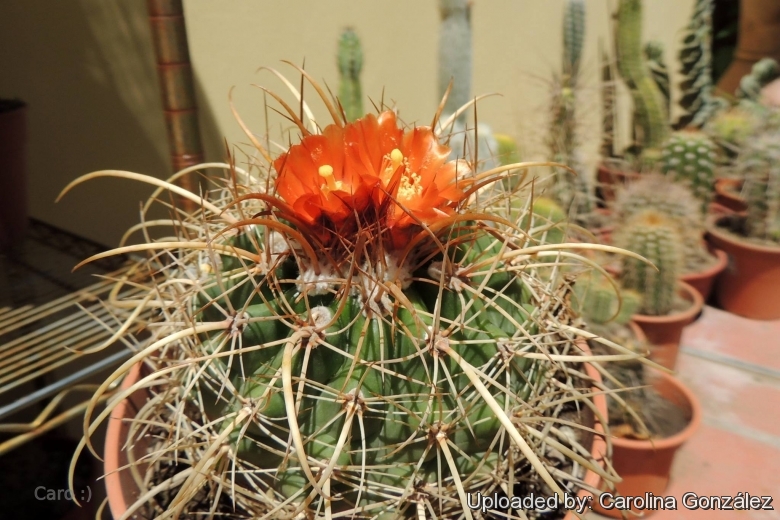
Bolivicactus maassii (Parodia maassii) Photo by: Carolina González
Origin and Habitat: It is native to Southern Bolivia (This species occurs in Argentina in Jujuy and Salta, and in Bolivia (Chuquisaca, Oruro, Potosi and Tarija). The species is widespread and common.
Altitude: It grows at elevations of 3,000 to 4,200 metres above sea level.
Habitat and Ecology: Parodia maassiiSN|5784]]SN|5784]] grows in high altitude grasslands on rocky outcrops. It is is widespread and common. It locally collected but this is not a major threat. It is locally threatened by sheep overgrazing
Synonyms:
See all synonyms of Parodia maassii
back
Accepted name in llifle Database:Parodia maassii (Heese) A.BergerKakteen (Berger) 344. 1929 (Often mispelled: maassi, masii, masi, massii or massi)Synonymy: 30
back
Common Names include:
RUSSIAN (Русский): Пародия Массии, Пародия Масса
Description: Parodia maassiiSN|5784]]SN|5784]] is a small globular South American cactus species with long hooked spines and yellow to red flowers. The extensive distribution range of this species has led to the formation of many local forms or varieties which in the years have been formally named. Most of these names are not accepted by many botanists that treat them as synonyms, but they still have a value for a collector because they identify plants with particular characters.
Habit: Solitary or clumping.
Stem: The plant presents an extended spherical stem, mid-green to intense green in colour, 15 cm. wide, with the apical part densely covered with white wool.
Ribs: 13- 21, chinned and arranged in spiral.
Areoles: Big and woolly at first, but they become naked with age.
Spines: Curved, dense, and variably coloured (yellowish or amber, but also white, pale to dark brown, brick red or nearly black).
Radial spines: 8-10 (or more). Usually yellowish or amber at first and white later, 5-10 mm. long, opened on the outside and a little curved inwardly.
Central spines: 1-4 (or more), strong, measuring between 3 and 7 cm. They are yellow on the upper part of the plant and go upwards. In older parts they become clear yellow, and go downwards.
Flowers: Funnel-shaped, large coppery-yellow or orange, but they can also be carmine or red with an orange centre. 3 (or more) cm across.
Blooming season: Spring and summer, they usually appear one by one in succession.
Subspecies, varieties, forms and cultivars of plants belonging to the Parodia maassii group
 Parodia maassii (Heese) A.Berger: has globular stems with long hooked spines and yellow to red flowers. It is extremely variable. Distribution: Southern Bolivia and Northern Argentina.
Parodia maassii (Heese) A.Berger: has globular stems with long hooked spines and yellow to red flowers. It is extremely variable. Distribution: Southern Bolivia and Northern Argentina. Parodia maassii f. cristata hort.: The crested form is very rare, and particularly sought after for its armament of long hooked spines. There are several clones with variable spination.
Parodia maassii f. cristata hort.: The crested form is very rare, and particularly sought after for its armament of long hooked spines. There are several clones with variable spination.- Parodia maxima F.Ritter: has larger stems, longer creamy-yellow hooked central spines (up to 7 cm long) and yellow flowers. Distribution: Cieneguillas, Paicho Valley, and adjacent areas, Tarija, Bolivia
 Parodia maxima f. cristata hort.: it is a robust crested form with long creamy-yellow hooked central spines.
Parodia maxima f. cristata hort.: it is a robust crested form with long creamy-yellow hooked central spines. Parodia suprema F.Ritter: has longer brown hooked central spines (up to 7 cm long) and red flowers. Distribution: Paichu-valley, Sama Pass to Iscayachi, Tarija, Bolivia.
Parodia suprema F.Ritter: has longer brown hooked central spines (up to 7 cm long) and red flowers. Distribution: Paichu-valley, Sama Pass to Iscayachi, Tarija, Bolivia.
Bibliography: Major references and further lectures
1) James Cullen, Sabina G. Knees, H. Suzanne Cubey “The European Garden Flora Flowering Plants: A Manual for the Identification of Plants Cultivated in Europe, Both Out-of-Doors and Under Glass” Cambridge University Press, 11/Aug./2011
2) David Hunt, Nigel Taylor “The New Cactus Lexicon” DH Books, 2006
3) Edward F. Anderson “The Cactus Family” Timber Press, 2001
4) Kiesling, R., Lowry, M. & Ortega-Baes, P. 2013. Parodia maassii. The IUCN Red List of Threatened Species 2013: e.T151775A560046. . Downloaded on 27 February 2016.
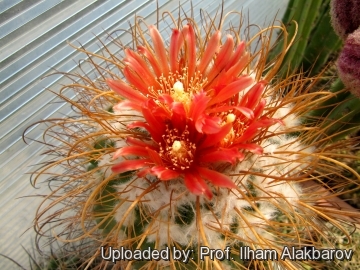 Bolivicactus maassii (Parodia maassii) Photo by: Prof. Ilham Alakbarov
Bolivicactus maassii (Parodia maassii) Photo by: Prof. Ilham Alakbarov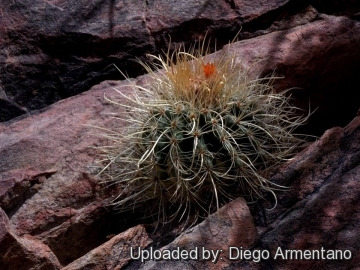 In habitat (northern Argentina). 3558 metres above sea level. (Parodia maassii) Photo by: Diego Armentano
In habitat (northern Argentina). 3558 metres above sea level. (Parodia maassii) Photo by: Diego Armentano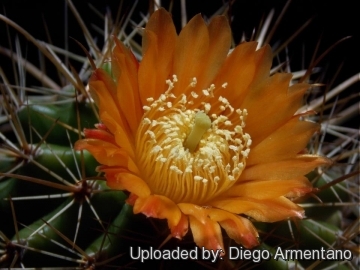 Bolivicactus maassii (Parodia maassii) Photo by: Diego Armentano
Bolivicactus maassii (Parodia maassii) Photo by: Diego Armentano Northern Argentina 3350 metres above sea level. (Parodia maassii) Photo by: Diego Armentano
Northern Argentina 3350 metres above sea level. (Parodia maassii) Photo by: Diego Armentano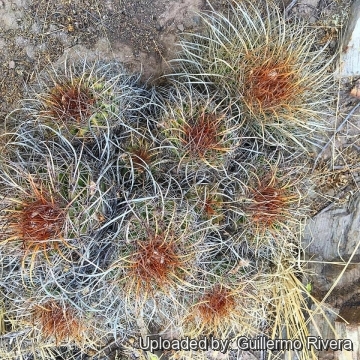 Parodia maassii a large clump, Bolivia. (Parodia maassii) Photo by: Guillermo Rivera
Parodia maassii a large clump, Bolivia. (Parodia maassii) Photo by: Guillermo Rivera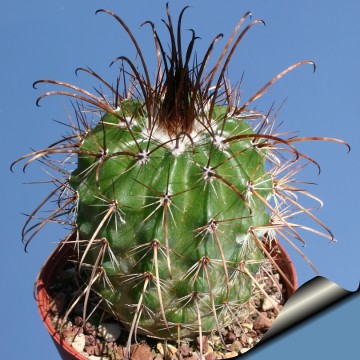 Bolivicactus maassii (Parodia maassii) Photo by: Cactus Art
Bolivicactus maassii (Parodia maassii) Photo by: Cactus Art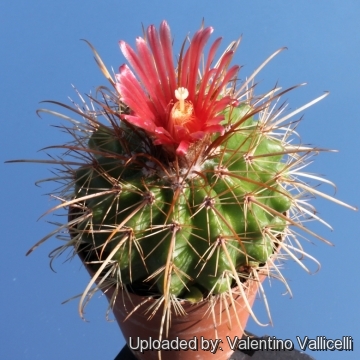 Bolivicactus maassii (Parodia maassii) Photo by: Valentino Vallicelli
Bolivicactus maassii (Parodia maassii) Photo by: Valentino Vallicelli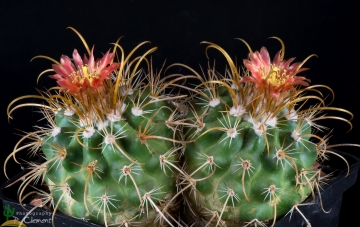 Bolivicactus maassii (Parodia maassii) Photo by: Peiffer Clement
Bolivicactus maassii (Parodia maassii) Photo by: Peiffer ClementCultivation and Propagation: Parodia maassiiSN|5784]]SN|5784]] is relatively easy to grow on its own roots and quite resistant to cultivation. The only things that can kill this plant are cold and overwatering. Nevertheless, it is appropriate to provide adequate growing conditions in order to obtain compact plant with many flowers.
Soil: Use a an open and free draining mineral compost with little organic matter (peat, humus) that allows therefore roots to breath (as it is rot prone). Outdoors a well-draining rocky or sandy soil is ideal.
Pots: It needs a relatively shallow pot to accommodate its fibrous roots and provide a very good drainage. It may stay in the same pot for many years.
Watering: Regular water in summer. Keep rather dry in winter, except for a quick, periodic misting on warmer days in late winter. It rots easily if the substrate is wet and cold, and tends to lose its roots in winter.
Fertilization: Fertilize with a low nitrogen fertilizer every 6 to 8 weeks, from mid-spring to late summer.
Hardiness: Keep dry at 5- 10° C in winter, but can tolerate sporadic light frost if kept on the dry side prior to, and during, cold weather.
Exposition: The plant tolerates very bright situations, if kept too dark they may become overly lush and greener and could be prone to rotting due to over watering. Strong light encourages flowering and heavy wool and spine production, but is likely to suffer from sun scorch or stunted growth if over exposed to direct sunlight during the hottest part of the day in summer. If your climate is warm enough to grow this plant outside, be sure that soil is well drained and sun if full, but with protection from strong mid-day rays.
Pests & diseases: It may be attractive to a variety of insects, but plants in good condition should be nearly pest-free, particularly if they are grown in a mineral potting-mix, with good exposure and ventilation. Nonetheless, watch carefully for any significant decline in health. This may signal a pest problem that should be dealt with quickly in order to prevent scarring, stunting and even death.
- Red spiders: Red spiders may be effectively rubbed up by watering or misting the plants from above.
- Mealy bugs: Mealy bugs occasionally develop aerial into the new growth among the leaves with disfiguring results, but the worst types develop underground on the roots and are invisible except by their effects. Eliminate mealybug infestations by dabbing the critters with cotton swabs dipped in alcohol or by soaking the succulent's roots in a systemic insecticide.
- Scales: Scales are rarely a problem.
- Rot: This species is particularly easy and accommodating, seldom suffer of cryptogamic diseases. Rot it is only a minor problem with cacti if the plants are watered and “aired” correctly. If they are not, fungicides won't help all that much.
Propagation: By Seeds. The seeds of this plant are extremely small, and must be sown on the surface of the germination substrate (not buried!!) But the seedlings after germination are so minuscule and delicate that it is quite problematic to keep them alive. So for this species one usually uses the baggy germination technique (in a sterilized pot hermetically closed in a plastic bag.
Your Photos
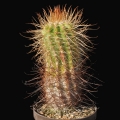
by Valentino Vallicelli
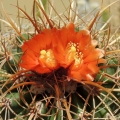
by Carolina González
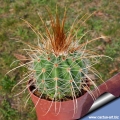
by Cactus Art
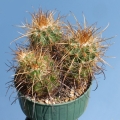
by Valentino Vallicelli

by Valentino Vallicelli























